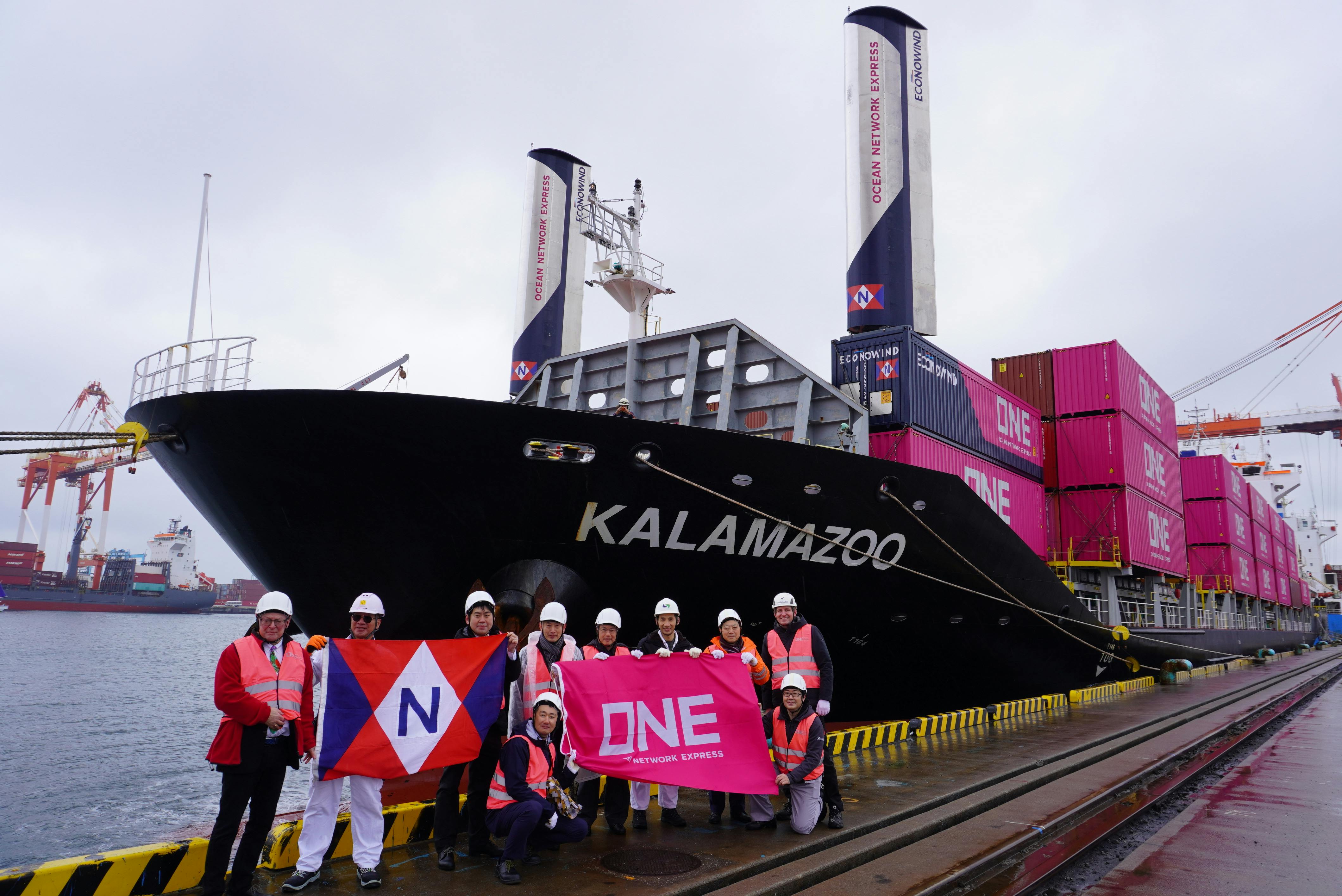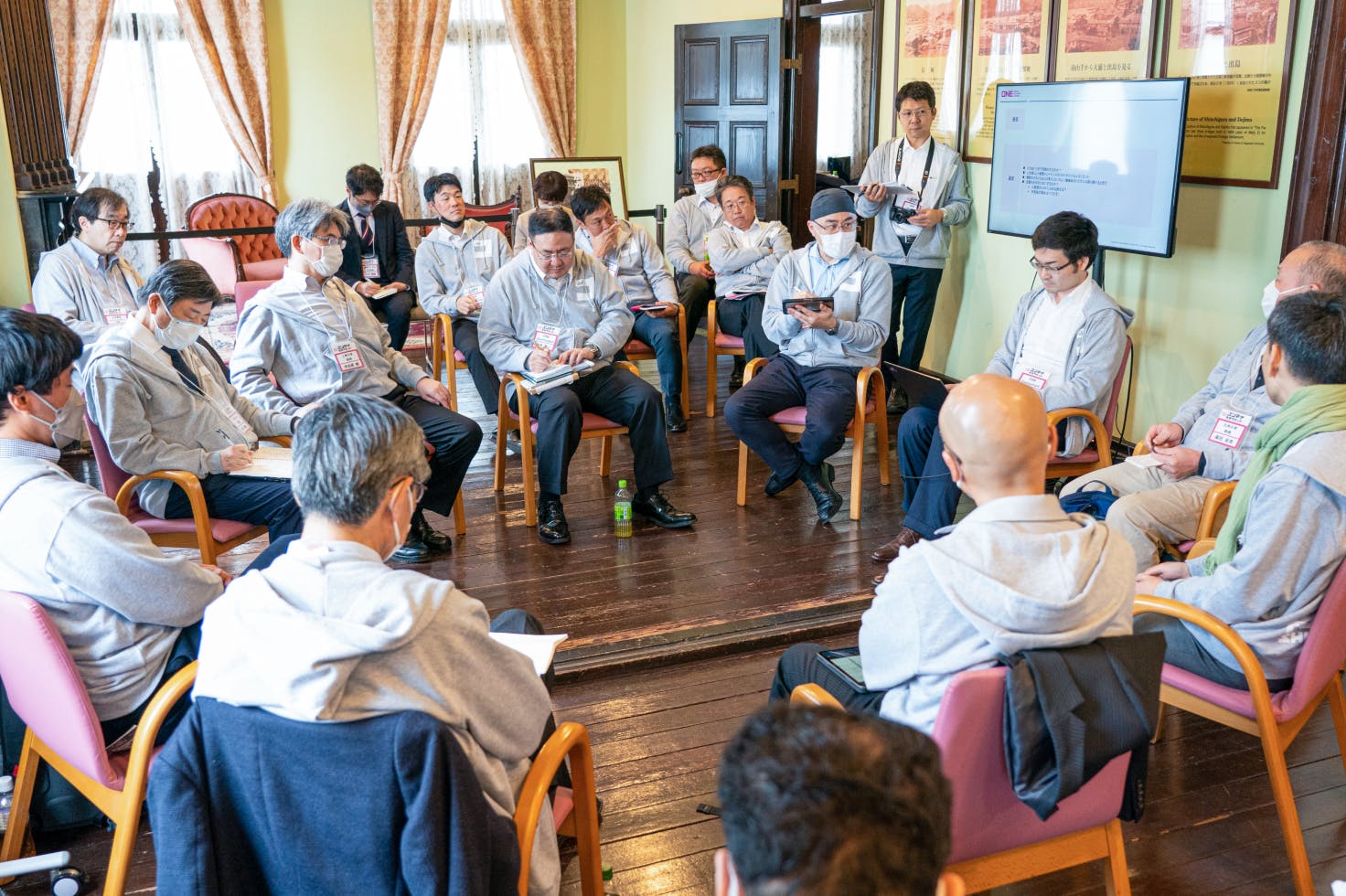From Trial and Error to Success: The Birth of the World’s First “Winged Container Ship”!
When you hear “the vessel sails using wind power,” what comes to mind? A sailing ship from long ago? No, in fact, the old-fashioned concept of “wind power” is now gaining renewed attention in the shipping industry. Wings rise from within containers, utilizing differences in air pressure to produce thrust. This experiment began on ONE’s Asia/Hawaii route and represents a world-first initiative. In this edition, our ONE correspondent goes behind-the-scenes on how the “winged container ship” was born.
A project to revitalize fuel-saving innovations!
“This project started with the desire to break free from stereotypes,” recalled Shota Kusu and Haonan Dou of ONE’s Singapore headquarters, who were involved in this project.
Reducing fuel consumption is crucial for a container shipping company like ONE as fuel costs account for a significant portion of operating costs. It’s no exaggeration to say that the company’s competitiveness depends on how well these costs are managed. The project, named “Sapphire,” has been a cross-departmental one, yielding impressive results. This initiative includes detailed monitoring of vessel movements, reducing berthing times at ports, optimizing container stacking, and modifying the vessels themselves. The scope of ONE’s efforts is so extensive that it’s too difficult to cover everything here.

Haonan Dou, Technical Department | Manager
However, as these initiatives yielded results and were incorporated into daily operations, new challenges emerged.
“The direction we’ve been working on isn’t wrong, and we’re seeing solid results, but it’s become routine, and the novelty has worn off,” Kusu said. “Around the time of the pandemic, I began to feel our efforts were becoming stereotyped, and I wanted to change that.”
The desire lead to the launch of “Sapphire Plus”, a project where a group of young and mid-career employees came together and brainstormed new, innovative ideas.

Shota Kusu Global Vessel Operations | Senior Manager
After brainstorming freely, the idea was narrowed down to “vessel wings”
The team members involved in the project were divided into various themes and began exploring new possibilities. They systematically investigated a wide range of ideas, such as researching shipping tech startups to identify promising technologies, and considering unproven services gaining attention in the industry. The brainstorming sessions for fuel-saving methods were free-from, with many unconventional ideas being considered.
One idea that emerged from these free discussions was a technology called “VentoFoil,” which uses wind power to propel vessels. Wind power is gaining significant attention in the shipping industry, not only for its potential to reduce fuel consumption, but also as a green energy source for decarbonization efforts. VentoFoil is an example of this. Wings are raised above a ship and act like sails, generating propulsion through the pressure difference between their two sides.
Let’s take a closer look at how the VentoFoil works.
At first glance, VentoFoils resemble the sails of a sailing ship, but this does not mean that the vessel moves forward with the wind’s assistance. If anything, they are closer in function to the wings of an airplane. There are multiple fans mounted within a VentoFoil, rotating to draw in air and generate lift around the wings. The ocean wind and the wings alone cannot create enough lift, but by drawing in air from the front, a relatively large force is generated by the narrow wing surface. In other words, this device generates a force that propels the vessel forward in the direction of the wind.

A VentoFoil is unfolded from a container (during a demonstration at the Port of Yokohama)
Once unfolded, a VentoFoil automatically adjusts its orientation to the wind direction, consistently generating lift towards the bow.
“This lets us use wind power to provide some of the propulsion that a vessel’s engines would normally provide,” Haonan explained. “As a result, the engine output is reduced, lowering fuel consumption and decreasing environmental impact.”
The technology is being developed by Econowind, a company based in the Netherlands. Today, the company is growing rapidly, but at the time of the project, it had a small number of employees and a modest factory.
“At first, I got the impression that it was a bunch of unusual people doing interesting things,” Kusu recalled.
However, upon further investigation, the technology appeared to fit the needs and operating conditions of container vessels, making it the most feasible option. Econowind was also interested in combining this equipment with a container and installing it on a container vessel. As they were looking for a partner, the two companies collaborated, and got on well right away. Haonan and Kusu said that the project took shape rapidly.
Challenges faced after launch, but “it was fun anyway”
From among the various candidates, they decided to go with the VentoFoil. Encouraged by their supervisor’s urging, they began discussions in earnest. However, “It was harder than we thought,” they recalled as the project got underway.
ONE has introduced container-type VentoFoils, which are stored inside containers the same size as a normal 40-foot container. The wings rise from inside the containers when they are activated on the open sea. A key feature is that they can be handled by cranes like normal containers and transshipped freely between container vessels. However, the project ran into various challenges due to its unprecedented nature.
For example, would the containers on board collapse when the wings were unfolded? When the wings caught the wind, would the load be too much for the containers beneath them to withstand? In addition to verifying these and other engineering issues, coordination and cooperation with various partners were essential when conducting tests on board an operational vessel. Detailed modifications are required to conduct the tests, so close coordination with the vessel’s owner is essential. Additionally, various other steps had to be taken with the shipyard, such as verifying drawings for the container-type VentoFoils’ installation and ensuring safety through inspection organizations.

Container-type VentoFoils with logos of project participants
Apart from the technical challenges, there was also an episode that got everyone excited: creating an original design for the VentoFoils. Initially, the plan was to depict only the Econowind logo, they eventually wanted to include the ONE logo as well. The public relations team came up with some design ideas combining the ONE logo, and the partnering shipowner. This sparked excitement among everyone involved. They even half-seriously considered adding the portraits of the ONE employees involved in the project. In the end, they settled on the current design, which symbolizes the collaboration and unity of the participating companies.
Shared wisdom and overcoming challenges to achieve net zero
The actual demonstration experiment was launched on the Asia/Hawaii route after researching weather and sea conditions in various ocean areas.

Commemorative photo at the Port of Yokohama for the start of testing
The two container-type VentoFoil units, assembled in the Netherlands and transported to Asia, arrived in Japan at the Port of Yokohama on February 23, 2024, after a long voyage. There, they were transferred to the “KALAMAZOO,” a container vessel operated by ONE on the Hawaii route. Despite poor weather that day with a dusting of snow, officials from ONE, Econowind, and Norse UK, the owner of the “KALAMAZOO”, gathered at the Port of Yokohama to commemorate the occasion. After the unveiling, the demonstration test finally began.
This video shows the VentoFoils unfolded on board the “KALAMAZOO” during its actual voyage to Hawaii, clearly demonstrating how the wings automatically turn according to the wind direction.
“The calculations suggest that it should be possible to reduce the ship’s fuel consumption by about 5%,” Haonan said hopefully. As the testing has only just begun, verification is pending. The plan is to accumulate as much usage performance data as possible in the future.
ONE is currently tackling the new challenge of achieving net-zero greenhouse gas emissions by 2050. Various approaches are being taken, including ordering state-of-the-art container vessels compatible with next-generation fuels, retrofitting existing vessels, and making relentless efforts to improve the operational efficiency. New initiatives such as the VentoFoils may not only help to save fuel but could also play a crucial role in achieving net zero in the future.
“It was good that this initiative was appropriate for the times,” Kusu and Haonan both reflected. “Many people were cheering us on, and everyone worked together to overcome the challenges.”
Today, in the world of shipping, the need for cooperation across departmental and company boundaries for untested initiatives is greater than ever before. The strength that made it possible to introduce this world-first container-type wind-assisted propulsion device will surely prove valuable in tackling new challenges in other areas. Keep an eye out for ONE’s next challenge and the future of winged container ships.
Efficiency
Sustainability
AS ONE, WE CAN.

The Power of Picture Books: Sharing ONE's Story An Invitation from ONE for Children, to the World Beyond Containers

Discussing the future of shipping with leading academia. ONE's new challenge "Container Shipping Summit"

Our mission is "Empowering Global Business from Nagasaki" Looking at the challenges of ONE DEJIMA, which is more than just marine transportation!


